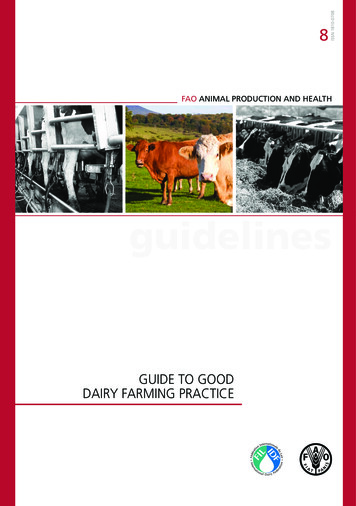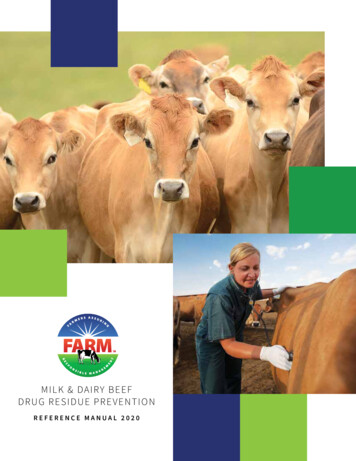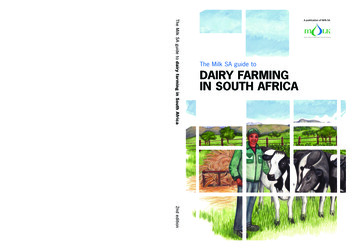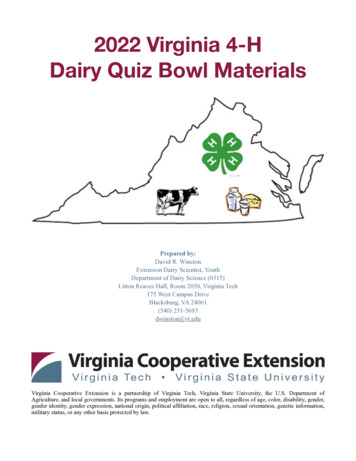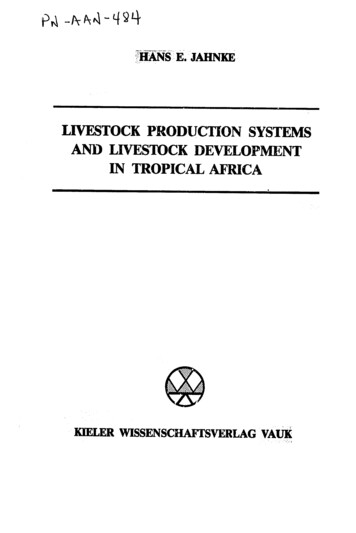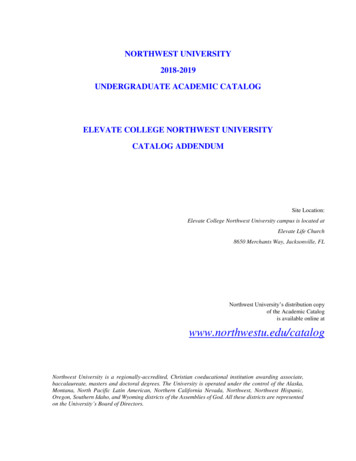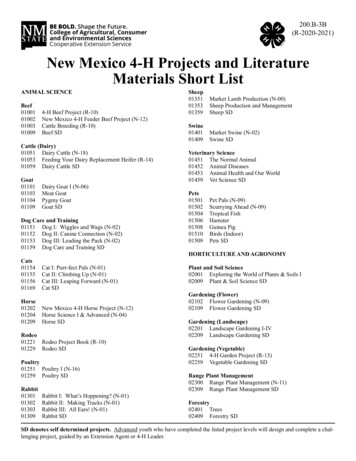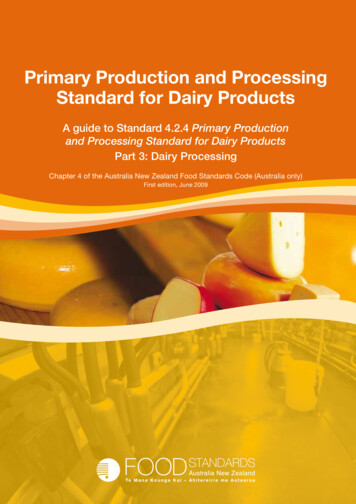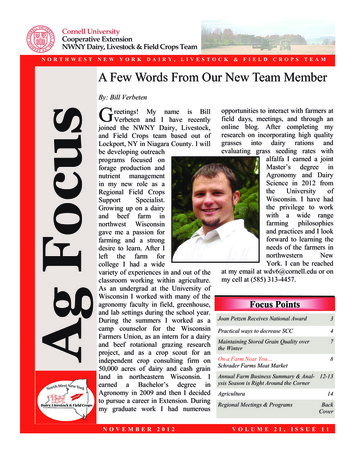
Transcription
NORTHWESTNEWYORKDAIRY,LIVESTOCK&FIELDCROPSTEAMA Few Words From Our New Team MemberAg FocusBy: Bill VerbetenGreetings! My name is BillVerbeten and I have recentlyjoined the NWNY Dairy, Livestock,and Field Crops team based out ofLockport, NY in Niagara County. I willbe developing outreachprograms focused onforage production andnutrient managementin my new role as aRegional Field CropsSupportSpecialist.Growing up on a dairyand beef farm innorthwest Wisconsingave me a passion forfarming and a strongdesire to learn. After Ileft the farm forcollege I had a widevariety of experiences in and out of theclassroom working within agriculture.As an undergrad at the University ofWisconsin I worked with many of theagronomy faculty in field, greenhouse,and lab settings during the school year.During the summers I worked as acamp counselor for the WisconsinFarmers Union, as an intern for a dairyand beef rotational grazing researchproject, and as a crop scout for anindependent crop consulting firm on50,000 acres of dairy and cash grainland in northeastern Wisconsin. Iearned a Bachelor’s degree inAgronomy in 2009 and then I decidedto pursue a career in Extension. Duringmy graduate work I had numerousNOVEMBER 2012opportunities to interact with farmers atfield days, meetings, and through anonline blog. After completing myresearch on incorporating high qualitygrasses into dairy rations andevaluating grass seeding rates withalfalfa I earned a jointMaster’s degree inAgronomy and DairyScience in 2012 fromtheUniversityofWisconsin. I have hadthe privilege to workwith a wide rangefarming philosophiesand practices and I lookforward to learning theneeds of the farmers innorthwesternNewYork. I can be reachedat my email at wdv6@cornell.edu or onmy cell at (585) 313-4457.Focus PointsJoan Petzen Receives National Award3Practical ways to decrease SCC4Maintaining Stored Grain Quality overthe Winter7On a Farm Near You Schrader Farms Meat Market8Annual Farm Business Summary & Anal- 12-13ysis Season is Right Around the CornerAgriculturaRegional Meetings & Programs14BackCoverVOLUME 21, ISSUE 11
Jerry BertoldoDairy ManagementGenesee County585.343.3040 x 133 (office)585.281.6816 (cell)grb23@cornell.eduAg FocusCornell Cooperative Extension ofGenesee Livingston MonroeNiagara Ontario Orleans SenecaWayne Wyoming YatesAg Focus is published Monthly by theNWNY Team of CCE / PRO-DAIRYLibby GaigeBilingual Dairy ManagementGenesee County607.793.4847 (cell)585.343.1275 (fax)geg24@cornell.eduEditor: Audrey BlountContributing Editors:Jerry Bertoldo · Libby GaigeNancy Glazier John HancharJoan Sinclair Petzen Mike StanyardJackson WrightNancy GlazierSmall Farms SupportYates County315.536.5123 (office)585.315.7746 (cell)nig3@cornell.eduLayout/Design: Cathy WallacePostmaster Send Address Changes:NWNY Team—Cathy Wallace420 E. Main Street, Batavia, NY 14020Direct all inquiries & correspondence on advertisingspace and rates to Cathy Wallace, advertising representative at 585.343.3040 x 138 Fax: 585.343.1275John HancharFarm BusinessLivingston County585.658.3250 x 112 (office)585.233.9249 (cell)jjh6@cornell.eduAlso ServingMonroe249 Highland AvenueRochester, NY 14620585.461.1000Orleans12690 State Route 31Albion, NY 14411585.798.4265Joan Sinclair PetzenFarm Business ManagementWyoming County585.786.2251 (office)716.378.5267 (cell)jsp10@cornell.eduMike StanyardField Crops & IPMWayne County315.331.8415 x 123 (office)585.764.8452 (cell)mjs88@cornell.eduBill VerbetenField Crops & SoilsNiagara County716.433.8839 x 238 (office)585.313.4457 (cell)wdv6@cornell.eduJackson WrightDairy ManagementOntario County585.394.3977 x 403 (office)585.746.3016 (cell)jbw243@cornell.eduPage 2Seneca308 Main Street Shop CentreWaterloo, NY 13165315.539.9252To simplify information, brand names of products may be used inthis publication. No endorsement is intended, nor is criticism implied of similar products not named.Every effort has been made to provide correct, complete and up-todate pesticide recommendations. Changes occur constantly &human errors are still possible. These recommendations are not asubstitute for pesticide labeling. Please read the label before applying pesticides.By law and purpose, Cooperative Extension is dedicated to servingthe people on a non-discriminatory basis.Mission StatementThe NWNY Dairy, Livestock & Field Crops team will provide lifelongeducation to the people of the agricultural community to assist them inachieving their goals. Through education programs & opportunities, theNWNY Team seeks to build producers’ capacities to: Enhance the profitability of their businessPractice environmental stewardshipEnhance employee & family well-being in a safe work environmentProvide safe, healthful agricultural productsProvide leadership for enhancing relationships between agricultural sector, neighbors & the general public.AG FOCUS NOVEMBER 2012 WWW.NWNYTEAM.ORG
Joan Petzen Receives National AwardBy: Jerry Bertoldo & Lisa KempistyAbelated congratulations to Joan Petzen, NWNYTeam Farm Business Management specialistand Agriculture Program Leader of WyomingCounty CCE, on her recent recognition at theNational Association of County Agricultural AgentsAnnual Meeting and Professional ImprovementConference held in Charleston, SC this July.NACAA is the nationwide, professional organizationof extension educators dedicated to both theprofessional improvement and personal growth of itsmembers.Joan received the 2012 NACAA AgriculturalAwareness and Appreciation Award whichrecognizes extension educators for their efforts toteach the public about agriculture. Joan was honoredwith a certificate and cash award at the luncheonwhere she made a superb presentation on herwinning project. She was recognized for herleadership in organizing and implementing theWyoming County Agri-Palooza launched in 2011 toaddress the need for local public education aboutagriculture. As co-chair of the Agri-Palooza, Joanworked with various Wyoming County agenciesincluding the Chamber of Commerce, Farm Bureau,Farmland Protection Board, and Soil and WaterConservation District. Joan helped coordinate some150 volunteers who provided farm tours, children’sdiscovery activities, good food and fun to over 2,000Joan receives her award from NYS Ag AgentsPresident Audrey Reith in Charleston, SCvisitors to VanSlyke’s Dairy Farm in 2011. In 2012Agri-Palooza was again a success with over 2,800attendees hosted at the Sondericker’s Friendly Acresthis past summer.Agri-Palooza is just one example of Joan Petzen’stireless efforts to advance and promote agriculture inwestern New York and her commitment tocommunity involvement that is so much part of herlife.AG F OC U S NOVE MBER 20 12 WWW. NWNYT E AM.OR GPage 3
Practical ways to decrease Somatic Cell CountBy: Jackson WrightThe recent construction of two yogurt plants inwestern New York will likely result in increaseddemands for high quality milk in western New York.Many factors can affect milk quality, however maintaining a low SCC may be themost important. This is becausemany consumers associate mastitis with inadequate animal welfare and milk with a high SCCaffects taste and may limit future export markets. Moreover,cows with a high SCC can reduce milk quality premiums andare likely to lose milk production over the course of lactation.Milk production is a function of mammary epithelialcell number and activity. In other words, the moreactively producing mammary epithelial cells themore milk produced. When a cow gets mastitis, organisms invade the quarter stimulating an immuneresponse. This process results in damage to the milkproducing cells within the gland. Moreover, somaticcells are not exclusively white blood cells. Soma islatin for “body” and somatic refers to “of the body”,meaning that somatic cells are cells of the body andactually consists of multiple cell types; includingwhite blood cells, cells lining the milk ducts, andmilk producing mammary epithelial cells. As the infection gets resolved the damaged milk producingcells in the udder get replaced with scar tissue, decreasing the milk production potential of the infectedquarter. Put simply, as SCC increases milk production decreases (See Figure 1).Linear ScoreSCC (cells/ml)Production Lost Per Lactation (lbs)2345678 0004008001,2001,6002,0002,400 The question then becomes how can we practicallydecrease SCC? Many times the answer lies in thePage 4milking routine. Briefly, udder preparation needs tobe firm but not harsh. Using the calf as an example, acalf will suck and head-butt the udder until milk isletdown. This cow/calf interaction causes the releaseof oxytocin into the blood stream. Once oxytocinreaches the mammary gland it acts on the myoepithelial cells to initiate milk letdown. This entire process takesapproximately 60-90 seconds.Therefore proper udder preparation should consistently cleanand dry the teats while timingattachment of the milking unitwith peak oxytocin release. Ifthe milking routine is painful,adrenaline may be releasedwhich can counteract oxytocin and prevent milk letdown. Finally, post dipping should ensure completecoverage of the teat. Adequate post-dipping shouldresult in excessive post-dip pooling near the teat endorifice, providing a barrier to entry until the teatsphincter can close.Often breakdowns occur when the milking unit isattached to dirty or moist teats. Many times this is theresult of milking personnel using dirty gloves between cows. Consider this: the recommendation formilking personnel to use latex gloves stems from thefact that bacteria are present on our skin. Usinggloves makes it harder for bacteria to “stick”. However, if gloves become contaminated with manurethey too harbor pathogens. This creates a dilemmabecause a consistent milking routine can be difficultto maintain if milking personnel are constantlychanging gloves. One way to address this issue is tomix rubbing alcohol with water at a 70:30 ratio ofrubbing alcohol to water, in a standard spray bottle.This can be used as an effective hand-sanitizer, disinfecting latex gloves that otherwise should bechanged. Since this is an alcohol based mixture, thisquickly evaporates, making it a practical way formilking personnel to clean their gloves during milking. Similarly, because this can be performed quicklymilkers can maintain a consistent milking routinewhile improving hygiene. This can provide additional incentives for milk quality premiums and improved milk production throughout lactation.AG F OC U S NOVE MBER 20 12 WWW. NWNYT E AM.OR G
The Academy for Dairy ExecutivesDeveloping Management and Leadership SkillsCome to the Academy for Dairy Executives to developthe necessary leadership and business management skillsto lead your dairy business into the future!Topics to be covered will include: Economic Decision Making Risk Management Partial & Whole Farm Budgeting Mission & Vision CommunicationParticipants will attend threesessions in 2013:January 22-23, 2013Country Inn & Suites, 130 N. Main StreetMt. Morris, NYMarch 12-13, 2013Beaver Hollow Resort & Conference Center1083 Pit RoadJava Center, NYNovember 19-20, 2013The Inn on the Lake, 770 South Main StreetCanandaigua, NYFor more information contact Joan Petzen: (Email: jsp10@cornell.edu, Office Phone: 585-786-2251 x122,Cell Phone: 716-378-5267) or visit our website: www.ansci.cornell.edu/prodairy/academy.AG F OC U S NOVE MBER 20 12 WWW. NWNYT E AM.OR GPage 5
Page 6AG F OC U S NOVE MBER 20 12 WWW. NWNYT E AM.OR G
Maintaining Stored Grain Quality over the WinterBy: Mike StanyardDespite another dry year, it looks like a betterharvest than expected for NY producers. Grainstorage is an important step in protecting yourinvestment and lots of money can be lost in reducedquality when it’s time to deliver. Longer term storagehas become an important part of the marketingstrategy particularly as current grain prices are at anall time high. As a result, chemical and culturalmanagement of yield robbing pests becomes evenmore important.I have talked about the importance of chemical andcultural control of insect pests prior to harvest in thepast but temperature and aeration are also a crucialpest management tool. Dry grain should be cooled toless than 60 degrees F as soon as possible afterharvest, and to 20 - 30 degrees F for winter storage.Temperature benchmarks for stored grain:80 F: The ideal temperature for insect and mold growth.70 F: Insect reproduction begins to decrease.50 F: Insects become dormant below this temperature.40 F: Mold growth prohibited below this temperature.20-30 F: Grain should be cooled to this range for winterstorage.Stored grain should be cooled by aeration wheneverthe grain temperature exceeds the average outdoortemperature by 10 to 15 degrees. Expect storage timeto approximately double with each 10 degreereduction in temperature. Grain should be cooled toabout 25 degrees as outdoor temperatures get colder.Check the condition of stored grain about every twoweeks while grain is cooling, then about monthlyafter grain has cooled for winter storage.When the fans are off during the winter holdingperiod, they should be covered (with canvas orplywood) to prevent the grain near the ducts fromgetting too cold during severe winter weather. Largetemperature differences result in condensation in thecold grain. Spoiled grain over the aeration ducts orperforated floor is a common problem caused by notcovering the fan during extended off periods. Alsolook for melting snow on the roof of the bin as atelltale sign of temperature problems.Accumulation of fine particles, weed seeds, andother foreign material interferes with airflow. Suchaccumulations are prime locations for increased moldand insect activity, which result in localized heatingand grain deterioration. Normally, these fines collectin the center of the bin as the grain flows toward thewalls.Several good management practices can reduce thestorage risks incurred through accumulation offoreign material. Screening the grain reduces theamount of foreign material and greatly improveslong-term storability. Spreaders are used to moreuniformly distribute fines throughout the bin andhelps provide more uniform airflow during aeration.A common practice in bins equipped with centerunloading hoppers is to unload some grain from thecenter “core” to remove some accumulated fines. Fillthe bin so it is peaked and unload some of the grain(300 to 1,000 bu, depending on bin size). Thisremoves some of the accumulation and increasesairflow in the center if enough grain is unloaded toallow the center core to fill with clean grain.References: “Management of Stored Grain withAeration”, University of Minnesota, ems/DC1327.html.AG F OC U S NOVE MBER 20 12 WWW. NWNYT E AM.OR GPage 7
On a Farm Near You.Schrader Farms Meat MarketBy: Nancy GlazierJust one year ago, Keith Schrader and JR Westerveltbegan the planning procedure for a processing facility. The Schraders saw aneed for a need for a USDA facility fortheir livestock processing and theirneighbors. USDA processing of meatallows for retail sales of single cuts ofmeat. Keith turned to JR, an experiencedmeat cutter. The two put their heads together and by March were breakingground for their USDA market in Romulus, Seneca County. They opened their doors August 23, 2012.Record time for a USDA plant? Not really, Keithsays. All the elements came together nicely. Keithalready owned the property, and critical pieces werenearby public water and sewer. The market is just ashort distance off Rt. 96 in Romulus. Their USDAinspector was helpful in advising them how to get thejob done. To help with the process, Keith workedwith a consultant to write the Hazardous Analysisand Critical Control Points (HACCP) plan. The planoutlines critical areas where meat needs extra care tostay “clean”. An example of a critical point is hideremoval; it is essential to keep the carcass clean fromany dirt and manure. A crucial piece to the puzzlewas the fact that JR was a trained meat cutter andnow plant manager. Keith admitted the occupation isa dying breed. Some of the Schrader family membersinvolved with the market have gone through the PennPage 8State HACCP training short course.The Schraders had the shell of theirstructure built and did the rest themselves. What helped keep the costs downwas purchasing used equipment from afacility that closed. Stainless steel is expensive. Therail system was the most beneficial since that piecewas a costly component. The goal of the meat marketis to slaughter 25 head of cattle a week and 15 hogs,plus some sheep and goats. They are not at capacityyet. They have been busy processing meat for otherproducers. They have a retail sales room and sell frozen cuts of beef and pork. They will soon have acooler for fresh cuts.Keith has a renderer come twice a week and pick upoffal. As processing numbers increase, pickup maybe increased.I’ve heard quite a bit of interest in the new facility.I’d like to get a tour together to visit. It would be anevening or Saturday afternoon. If interested, let meknow!Nancy Glazier: nig3@cornell.edu or my cell:585.315.7746AG F OC U S NOVE MBER 20 12 WWW. NWNYT E AM.OR G
AG F OC U S NOVE MBER 20 12 WWW. NWNYT E AM.OR GPage 9
“Measure to Manage”Group-Housed Calf Systems SymposiumUnderstanding Respiratory Challenges and Learning to Winne:on deadlitiatrisgee 50!Early rr 15—SavNovembeDecember 12 & 13, 2012 For the new or experienced group calf raiser Producers telling their own storyDoubletree Hotel6301 State Route 298Syracuse, NY Ideas for planning a new calf barn Industry and university speakers Updates on field and lab research findings What’s coming down the roadFor information on speakers, agenda, registration & hotelGo to: www.ansci.cornell.edu/prodairy/calfsystemsPage 10AG F OC U S NOVE MBER 20 12 WWW. NWNYT E AM.OR G
Dairy Skills TrainingKeeps Rolling OnThe continuing practical training of dairy farmpersonnel continued in September with 25 participants taking part in the “Hoof Health and Lameness” module. The team continued its collaborationwith the Wyoming County Dairy Institute led by BillMaddison. Although not a new offering, this modulewas notable for the number of partners involved withteaching and the degree of practical information presented. The Cornell Vet School, NYSCHAP program, Zinpro Corporation, Agro-Chem and the HoofTrimmers Association joined with NWNY teammembers in this 15 hour program.Next on the list is a four evening look at dairy records, “Measure to Manage” – The Use and Evaluation of DHIA Records (see facing page for details).We are pleased to have the very busy and talentedGeorge Cudoc and Wayne Saxton of DHIA as ourinstructors for this module. This module is designedfor farms not using computer based records pro-grams, but will be quite useful for anyone usingDHIA generated reports or those from your owncomputer. For those not on test, you will be able tosee how records are the basis for sound economicdecisions. To manage something you have to be ableto monitor changes and monitoring means collectingand recording good information on things that youcan measure.Coming in 2013 QuickBooks for Dairies: January 7-11,Calf Management: February 5,7,12, 14 & 16Nutrient Management: March 5,7,12, 14 & 16For more information or to register for these coursesplease contact Wyoming Co. Dairy Institute:585.786.2251or visitwww.WyomingCountyDairyInstitute.comTHANK YOU For providing quality dairy productsover many years for our variousprograms and workshopsAG F OC U S NOVE MBER 20 12 WWW. NWNYT E AM.OR GPage 11
Annual Farm Business Summary and Analysis Season isRight Around the CornerBy: John HancharRisk management continues to be a commonchallenge faced by farm business owners, and aprominent element in agricultural policy development and debate. Risk management tools and theiravailability continue to receive emphasis.Summary Sound financial planning and control are keys tosuccessfully managing agricultural risks. The next few months present good opportunitiesto evaluate your business’ financial managementpractices. The NWNY Dairy, Livestock, and Field CropsProgram has the capacity to work with a varietyof producers as they seek to improve their business’ financial management practices.RiskRisk is variability in outcomes. Agricultural risksrelate to production, market, legal, human resources,and financial aspects of the business. For farm businesses, production, prices (both output and input),and financial outcomes, among others vary. Resultsare not known with certainty. The ability to meetcash obligations in a timely manner, the ability togenerate profits, and other financial outcomes are notknown with certainty -- they vary over time.Sound Financial Planning and Control are Keysto Successfully Managing RisksAn overall strategy for successfully managing finan-cial risk includes sound financial planning and control.Financial planning is using financial information toanswer the following questions.1. Where is the business now?2. Where do you want it to be?3. How will you get the business to where you wantit to be?Financial planning practices include generating financial statements (balance sheet,cash flow statement, and income statement) using results to identify strengths and weaknesses developing projections, including those associated with proposed changes to the farm business.Financial control involves measuring financial condition and performance over time to determine whetheror not the business is achieving desired results, and ifnot asking, “Why not?” to identify and implementneeded changes.As the end of the year draws near, the next fewmonths present good opportunities to examine yourbusiness’ financial management practices. As a farmbusiness owner, you have financial objectives andgoals, written hopefully, or unwritten. These directyour efforts. Do you measure the financial conditionof your farm business using the balance sheet? Doyou measure financial performance using the cashflow statement and income statement? If you don’tmeasure financial management factors, then how doyou expect to successfully manage the business toward achieving desired financial results?The statement “If you can’t, or don’t measure it, thenyou can’t manage it” with its emphasis on measuringoutcomes underlies the value and need for sound financial management, especially as it relates to successfully managing risks.Page 12AG F OC U S NOVE MBER 20 12 WWW. NWNYT E AM.OR G
Business Summary and Analysis ToolsCornell University Cooperative Extension’s DairyFarm Business Summary (DFBS) Program The objective of the DFBS Program is to allowproducers to analyze their production andfinancial situation, set future goals, and makesound financial decisions. The DFBS also allows producers to comparetheir business performance to that of other dairyproducers. The summary and analysis for each farm includesprofitability analysis, balance sheet analysis,analyses of annual cash flows and repaymentability, capital and labor efficiency as well asanalyses of the cropping and dairy aspects of thebusiness.summary and analysis for 2012. Owners of all typesof farm businesses are encouraged to contact me.The NWNY Dairy, Livestock, and Field CropsProgram has the capacity, using the above tools, todevelop valuable farm business summary andanalysis. The NWNY team has the capacity anddesire to work with a variety of farm businesses -dairy (small, medium, and large; conventional;organic; grazing; and others), field crop, livestock,and others.John Hanchar, jjh6@cornell.edu, (585) 233-9249.The DFBS program is a preferred financialmanagement tool for summary and analysis for dairyfarm businesses of all kinds.Financial Statements for Agriculture (FISA)Program FISA is a computer based spreadsheet programthat can be used by all types of farm businessesto achieve an objective similar to the one abovefor the DFBS Program. In practice, FISA’s ability to provide for peer topeer comparisons is limited. The summary and analysis for each farm includesprofitability analysis, balance sheet analysis,analyses of annual cash flows and repaymentability, as well as some capital efficiencymeasures and analysis. The program does notsummarize and analyze production aspects of thebusiness.Farm Business Summary and Analysis with theNWNY Dairy, Livestock, and Field CropsProgramIf you are interested in improving your farmbusiness’ ability to practice sound financialmanagement, then please contact me to learn moreabout some of the tools available and their value and/or to discuss plans for completing a farm businessAG F OC U S NOVE MBER 20 12 WWW. NWNYT E AM.OR GPage 13
AgriculturaBy: Libby GaigeQueso in GuatemalaDo you know where your Hispanic employeesare from? The majority of Hispanic employeesthat I’ve met in Western New York come from Mexico, though I’ve also come across a number fromGuatemala. Regardless of their nationality, most arefrom rural areas, and many grew up with animals;possibly cows, horses, pigs or goats, but almost certainly chickens. (It’s quite difficult to escape thecrackly wakeup call of a rooster in Guatemala, evenin urban areas!) Despite the fact that many workedwith cows in their home countries, most come toNew York having had no experience with moderndairying. Did you ever stop to think what the dairyindustry is like where they come from? While I can’tspeak to Mexico, I can speak from personal experience about Guatemala.One pound blocks of cheese are formed by pressing it intowooden molds.ple in the Guatemalan human diet). A few actuallyplant corn to make silage.During my service as a Peace Corps volunteer, Ilived in a village located in a mountainous region ofeastern Guatemala. The cool climate makes it a muchmore suitable environment for dairy cows than thehot, humid climates at lower elevations, so manyfamilies have a few cows. My host family milkedtheir herd of 10 cows once a day by hand and soldmost of the milk to a local cheese maker. The cheesemaker owns a small building in the village wheredairymen bring their milk by truck or horse everymorning. He makes cheese daily and sells it in thelarger towns within about an hour’s radius from thevillage. The whey left over after making cheese isgiven to local women who feed it to pigs they raiseto sell for meat.I enjoyed my host mom’s fresh cheese for monthsbefore she taught me how to make a traditional quesofresco. The milk is strained, and then heated (if notstill warm from the cow). Rennet is added and themilk is left at room temperature for three to sixhours, until it solidifies. Then it’s strained through acheese cloth, salted, kneaded, and pressed into formsthat make a one pound block of cheese. After aboutan hour the cheese will hold its form and can be removed from the mold and eaten. A one pound blockof cheese sells for about 12 Quetzals (roughly 1.50).Alternately, the cheese can be left to cure for a fewmonths to produce an aged cheese, or the whey canbe boiled to produce requeson, which is similar toricotta cheese. An interesting bit of local lore: pregnant women can’t make cheese because the milkwon’t curdle.Since Central America has two seasons (6 months ofrain and 6 months without rain) and farmers rely primarily on pasture to feed their cows, milk productionis very seasonal. Therefore farmers don’t get paidmuch during the green, grassy, rainy season, but getpaid handsomely if they have cows producing milkduring the dry season. Some farmers have small stationary choppers they use to process the dry cornstalks left over from the grain harvest (corn is a sta-When was the last time any of you milked a cow outby hand? My host family was shocked when I toldthem that I had only ever milked a cow with a machine. (They remedied that situation pretty quickly.)As can be expected from the production system I’vedescribed, cows in Guatemala don’t make muchmilk. But I suspect that fifteen or twenty pounds aday looks a lot better than 85 when you milk byhand!Page 14AG F OC U S NOVE MBER 20 12 WWW. NWNYT E AM.OR G
AG F OC U S NOVE MBER 20 12 WWW. NWNYT E AM.OR GPage 15
Cooperative Extension Association of LivingstonNWNY Dairy, Livestock & Field Crops Team158 Main StreetMount Morris, NY 14510Nonprofit Org.U.S. POSTAGEPAIDPermit No. 298Rochester, NYPostmaster Dated MaterialPlease ExpediteSave the Date.December, 201212Field Crop Dealer Meeting, 1:00—5:00 p.m., Genesee Grande, 1060 East Genesee St., Syracuse. Cost: 15, credits pending.Please pre-register for the meeting online at: http://nysaba.com/meeting registration Contact: Mary McKellar 607.255.217712-13Group-Housed Calf Systems Symposium, Doubletree Hotel, 6301 State Route 298, Syracuse. For more information go to:www.ansci.cornell.edu/prodairy/calfsystemsSave the Date for 2013.January, 201316WNY Corn Congress, 9:00 a.m.—3:00 p.m., Clarion Hotel, 8250 Park Road, Batavia. DEC credits pending. For moreinformation contact: Cathy Wallace 585.343.3040 x138 or cfw6@cornell.edu17Finger Lakes Corn Congress, 9:00 a.m.—3:00 p.m., Holiday Inn, 2468 NYS Route 414 Waterloo. DEC credits pending. Formore information contact: Cathy Wallace 585.343.3040 x138 or cfw6@cornell.edu22-23Academy for Dairy Executives, Country Inn & Suites, 130 N. Main St. Mt. Morris. For more information contact: JoanPetzen 585.786.2251 x122 or jsp10@cornell.eduFebruary 20136WNY Soybean/Small Grains Congress, 9:00 a.m.—3:00 p.m., Clarion Hotel, 8250 Park Road, Batavia. DEC creditspending. For more information contact: Cathy Wallace 585.343.3040 x138 or cfw6@cornell.edu7Finger Lakes Soybean/Small Grains Congress, 9:00 a.m.-3:00 p.m., Holiday Inn, 2468 NYS 414 Waterloo. DEC creditspending. For more information contact: Cathy Wallace 585.343.3040 x138 or cfw6@cornell.eduMarch, 201312-13Academy for Dairy Executives, Beaver Hollow Resort & Conference Center, 1083
grb23@cornell.edu Jackson Wright Dairy Management Ontario County 585.394.3977 x 403 (office) 585.746.3016 (cell) jbw243@cornell.edu Joan Sinclair Petzen Farm Business Management Wyoming County 585.786.2251 (office) 716.378.5267 (cell) jsp10@cornell.edu Libby Gaige Bilingual Dairy Management Genesee County 607.793.4847 (cell) 585.343.1275 (fax)
